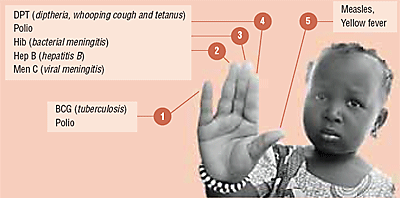Many people have difficulty remembering the schedule for childhood immunisation. This means that children often miss some or all of a series of immunisations that can protect them against polio, hepatitis B, diphtheria, tetanus, and other preventable diseases.
The schedule recommended by the World Health Organisation includes at least six different vaccines, which are given over the course of 5 visits, taking place at birth and then at 6 weeks, 10 weeks, 14 weeks, and nine months of age. Parents who can’t read don’t benefit from written reminder cards or health cards issued at their child’s birth. How can we help them remember when to take their infants to be immunised?
Song, mime, theatre and games are all good ways of sharing health information with people who cannot read. Trainers, teachers, and facilitators can use them to illustrate health messages, stimulate discussion, teach participants new skills, and create simple memory aids.
The ‘Use your hands’ activity (see below) can be used in a workshop or during community education sessions. Trainers teach health workers, school children and parents to recite the poem and count off the necessary visits on a hand. To reinforce the message, a poster and radio item have been produced. The poem can be translated, adapted, and presented as a song, chant or rap. This is particularly effective if the words can be sung to the tune of a well-known local song.
Use your hands
People can learn to remember messages using their bodies. In Benin, PROSAF staff (the Integrated Family Health Project) developed a learning activity called the ‘Immunisation hand’ which encourages people to use their fingers and a poem to remember the schedule.
Step 1 Discuss with participants the advantages of immunisation and the dangers of not using it to protect a baby against childhood illness.
Step 2 Ask participants to hold up their hand, separating the thumb and little finger while holding the three middle fingers together.
Step 3 Show how each finger can demonstrate an immunisation visit, and the vaccines which may be used. (Different countries may follow a slightly different schedule, depending on the national immunisation programme.)
1 LITTLE FINGER - FIRST VISIT - AT BIRTH
2 RING FINGER - SECOND VISIT - AT 6 WEEKS
3 MIDDLE FINGER - THIRD VISIT - AT 10 WEEKS
4 INDEX FINGER - FOURTH VISIT - AT 14 WEEKS
5 THUMB - FIFTH VISIT - AT NINE MONTHS







